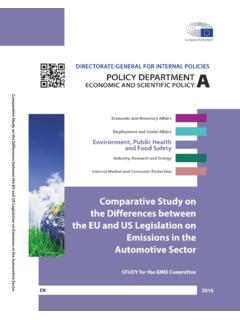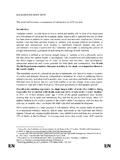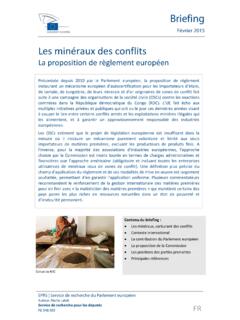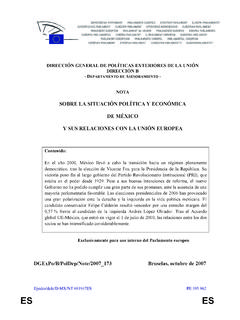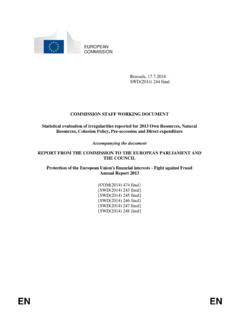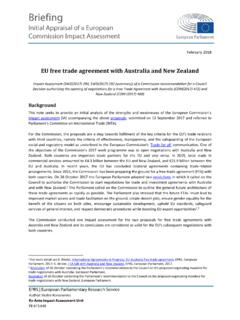Transcription of Japan's ageing society - European Parliament
1 BRIEFING Continental democracies EPRS | European Parliamentary Research Service Author: Enrico D'Ambrogio Members' Research Service PE December 2020 EN Japan's ageing society SUMMARY Japan is aging fast. Its 'super-aged' society is the oldest in the world: % of the population are 65 or older, with women forming the majority. The country is also home to a record 80 000 centenarians. By 2036, people aged 65 and over will represent a third of the population. Since 2011, the Japanese population has also been shrinking: it is a rare case of large country whose overall population is becoming smaller in prosperous and peaceful times. Japan's population is expected to drop from 127 million in 2015 to 88 million by 2065. Japan's demographic crisis is the consequence of the combination of two elements: a high life expectancy and a low fertility rate. In 2018, Japan had the second highest life expectancy in the world.
2 Meanwhile, since the 1970s the country has failed to raise its fertility rate to the replacement level. The working culture, a deterioration of employment opportunities for young men and the traditional gender division of labour are possible explanations for this trend. The consequences of the country's aging and shrinking population include economic crisis, budgetary challenges, pressure on job markets and depopulation of rural areas. The silver economy is meanwhile flourishing and Japan is at the forefront of robot development to face a declining labour force and to take care of its elderly. The government's efforts to address the demographic crisis have yet to succeed however, and immigration has been limited. Tokyo is engaged in global health cooperation and succeeded in incorporating the concept of human security in the sustainable development goals.
3 It has also been active in international cooperation on ageing , with a focus on the Association of Southeast Asian Nations (ASEAN) region. The EU's own ageing society is not far behind Japan. It could benefit from learning from Japan's experience, and cooperating on all aspects relating to demographic challenges, including on 'agetech': technology making comfortable longevity accessible to all. In this Briefing A rapidly ageing country The root of the phenomenon Socioeconomic consequences of an ageing society Government policies Demography: A challenge common to Japan and the EU Japan's ageing society 2 A rapidly ageing country A 'super-aged' society With a median age of 48, the world's highest,1 Japan is the globe's fastest ageing country. It can be defined as a 'super-aged' society , a country where more than one in five of the population is 65 orover. In Japan, in fact, more than one in four people are 65 or over % of the population, making up million (almost thepopulation of Poland), according to government statistics releasedin September 2020; this makes Japan the country with the oldestpopulation by far.
4 The EU average in 2019 was % (see box).Almost one in three women in Japan is 65 or over ( %). Peopleaged 70 or over represent % of the total population, and one infour women now falls within this age range ( %). The populationaged 90 and over had already reached two million in 2017. Japanalso has a record number of centenarians: over 80 000. This figureis expected to rise to 440 000 by 2050. Most of Japan's centenarians(approximately 88 %) are women. In November 2019, Japan washome to 150 supercentenarians (people aged 110 or over).A shrinking (and ageing ) population Japan's demographic 'pyramid' lost its shape in the 1990s, when a structural shift resulted in a bulge in the middle-aged and older area. The current impression is more of an urn (see box on next page), with the pyramid covering a smaller area, representing a diminished population. Japan had a baby boom right after World War II, but this was much shorter-lived than in other countries (from 1947 to 1949).
5 A second baby boom followed from 1971 to 1974. However, since 1974, the country has failed to raise its fertility rate to the replacement level of The issue gained national attention in 1990, with the so-called ' shock', when Japan's birth rate fell to its lowest recorded level in history. In 2018, the rate was children per woman (it was in the EU, ranging from in Malta to in France). Japan's population has been constantly shrinking since 2011: in 2019, it diminished by 276 000 people, decreasing in 40 out of 47 prefectures. If Japanese nationals only are considered, the population fell by 487 000 people, which means that immigration only partially offsets the falling numbers of Japanese locals. Based on October 2020 projections, the population was million. The forecasts for Japan's population size are especially alarming.
6 In 2017, the National Institute of Population and Social Security Research estimated that Japan's population was expected to decrease from 127 million in 2015 to around 111 million by 2040, to fall below 100 million by 2053, and to drop to 88 million by 2065. These projections consider a medium-fertility scenario; in the case of a low-fertility scenario, the population would drop to 82 million by 2065. By 2036, the number of people aged 65 and over will make up one-third of the population. While their number is set to begin falling after 2042, their share of the population will rise to 38 % in the 2060s. In the EU, one in three people will be over 65 by 2060. Respect for the Aged Day (Keiro no Hi) has been a Japanese national holiday since 1966. It is currently celebrated on the third Tuesday of September. Table 1 Countries with the largest share of population aged 65 or over, 2019 Country 65+ % Japan Italy Portugal Finland Greece Germany Bulgaria Croatia Malta (EU) France Latvia Sweden Slovenia Lithuania Estonia Denmark Czechia Hungary Spain Netherlands (World) Japan's ageing society 3 Figure 1 Japan's demographic pyramid in 1960, 2020 and 2045 1960 2020 2045 Source: Statistics Dashboard, Government of Japan.
7 Data for 2020 and 2045 are projections. Japan's ageing society 4 The root of the phenomenon Japanese people live longer Japan's demographic crisis is the consequence of the combination of two elements: high life expectancy and a low fertility rate. Life expectancy for the Japanese population has increased steadily over the past few decades. In 2019 it was years for women and for men. In 2018, at , Japan had the world's second highest rate after Hong Kong for life expectancy at birth. Life expectancy at birth in the EU-27 was estimated at in 2018: for women and for men. Several factors have combined to improve health among the Japanese population: traditionally healthy dietary habits, access to clean water, universal health insurance coverage (UHC), a hygiene-conscious culture, and old people's active lifestyles. Experts also point at further elements. Economic development, for instance, has been associated with major factors of decline in older adult mortality in high-income countries during the twentieth century.
8 Nevertheless, Japan's economic recession in the 1990s did not prevent life expectancy from continuing to grow during and after the recession. On top of this, there is the example of Okinawa prefecture, which is socio-economically the country's least developed region, but has retained the highest life expectancy ranking for many years. Other possible explanations include genetics, a low level of income inequality, and a high level of social cohesion. Japanese have fewer children Japan's fertility rate began to decline in the It reached its minimum in 2005 ( ), then bounced back, though never to replacement levels. In 2016 it began declining again (to in 2019). This is combined with increasing age at first marriage and decreasing rates of marriage: in 2015, the proportion of people who had never married aged 50 was at a record high of % for men and % for women.
9 This has contributed to a lower birth rate in Japan in 2018 a mere % of children were born outside marriage. The Covid-19 pandemic has added to this trend: the number of notified pregnancies in the three months to July 2020 fell % from a year earlier, while the number of marriages over the same period dropped by %. According to Matsutani Akihiko, professor emeritus in applied economics at the National Graduate Institute for Policy Studies, Japan's ongoing population decrease is not related to its low birth rate, but rather to an increase in the number of deaths of people born during the baby boom right before World War II. The pace of deaths will increase until it peaks in around 2030, resulting in an acceleration in the decline in population. After that, the population will keep falling because of the low birth rate. One of the main reasons for this lower birth rate is the deterioration of employment opportunities for young men, who could find life-long jobs more easily in the past.
10 This affects their possibilities of settling down, including their marriage chances: some argue that Japanese women tend to seek men in stable employment and a level of education higher than their own. A 2019 study on virginity rates showed that the lack of heterosexual sexual experience is rising, and that men with permanent, full-time and well-paid jobs were more likely to have had sex. Japan's working culture is partly responsible. Long working hours due to social norms and work conventions, and subsequent stress and fatigue, have also been connected to the low fertility rate. However, the main problem may lie in the persistence of the traditional gender division of tasks within families, which places a heavy obligation on women to take care both of childcare and their household. In addition, as the education system is highly competitive and expensive, mothers often have to make sure that their children are successful.
